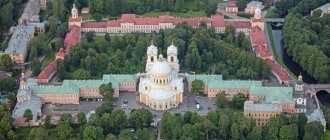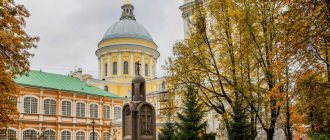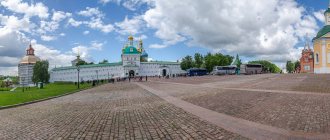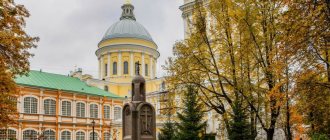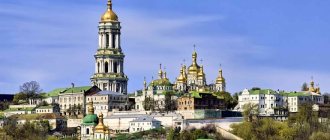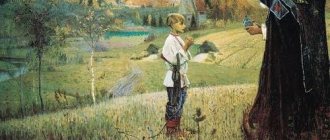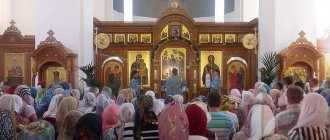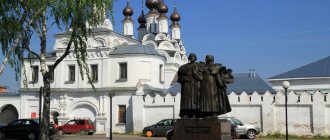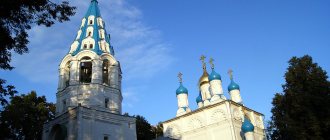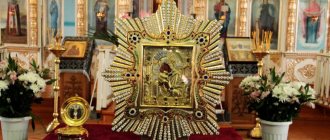TASS DOSSIER. On November 23, 2022, the Ministry of Justice of Ukraine canceled the decision on state registration of the transfer of the complex of buildings of the Holy Dormition Pochaev Lavra to the use of the Ukrainian Orthodox Church (UOC, a self-governing church within the Moscow Patriarchate). This was announced by the First Deputy Minister of Justice of Ukraine Elena Sukmanova. The chairman of the legal department of the UOC, Archpriest Alexander Bakhov, said that the decision of the Ministry of Justice to cancel state registration (removal from the register of an entry) on the right to use the buildings of the Pochaev Lavra does not cancel the agreement on use since 2003. According to him, the right of use acquired before 2013 is not subject to mandatory state registration.
On November 23, 2022, a statement by the brethren of the monastery was published on the official website of the Pochaev Lavra. It says that the inhabitants of the monastery regard the actions of the authorities as an attempt to “destroy monasticism in the territory of western Ukraine.” According to the brethren, the goal of government agencies is to transfer the property of the Pochaev Lavra to a newly formed church organization controlled by the Patriarchate of Constantinople.
The editors of TASS-DOSSIER have prepared information about the history and current situation of the Pochaev Monastery.
The Holy Dormition Pochaev Lavra is one of the largest historical Orthodox monasteries. Located in Pochaev, Ternopil region of Ukraine. It is a major center of Orthodox pilgrimage.
Story
Start
According to legend, the monastery was founded by monks of the Kiev Pechersk Lavra, who fled from the Tatar invasion in 1240. The first chronicle mention dates back to 1527.
The era of Job Pochaevsky
In 1597, the monastery received significant land, estates and the miraculous image of the Mother of God as a gift from the local landowner Anna Goyskaya. In 1649, a new stone church of the monastery was built at the expense of the Domashevskys Fyodor and Eva.
August 2, 1675. A fifty-thousand-strong Turkish-Tatar army under the leadership of Khan Nurredin approached Pochaev. Residents of neighboring settlements came running to the monastery, which at that time was surrounded only by a rough wooden palisade. Everyone who was able to hold a weapon, both from among the monks and from among the laity, began to defend the monastery. According to legend, while reading the akathist in front of the icon of the Pochaev Mother of God, the clouds suddenly parted in the sky and the Mother of God herself appeared above the cathedral in a brilliant radiance, surrounded by angels, and next to her the praying Job of Pochaev.
The monastery flourished in the first half of the 17th century in connection with the activities of Abbot Ioann Zhelez, aka Job of Pochaev (1550-1651).
Greek Catholic period
From 1713 to 1831, the Pochaev Monastery was Greek Catholic. During this period, the following were built: the main temple of the Lavra - the Holy Assumption (1771-1791), a refectory, and monastic cells. Funds for the reconstruction of the monastery were allocated by M. V. Pototsky, the architect was Jan Gottfried Hoffmann. The general composition of the complex is terraced, the buildings are located on slopes with a gradual increase towards the main one - the Assumption Cathedral. The main façade is decorated with two towers, according to Catholic tradition - at an angle of 45° to the main axis, emphasizing the all-facade nature of the cathedral - a characteristic feature of Ukrainian churches. In general, the composition with one central dome on an octagon and two side towers is in tune with the best examples of Cossack Baroque - the cathedrals of the Trinity Monastery in Chernigov and the Mgar Monastery near Luben in the Poltava region.
Since 1730, the Pochaev printing house operated, publishing 187 books. The Lavra is richly decorated with wall paintings, sculptures and ornaments.
Abbess of Job Pochaevsky
With the abbess of Job Pochaevsky (1617/1623 - 1649), a new era in the history of the Pochaev monastery began. The Monk Job of Pochaev (1551-1651) was a great ascetic, a supporter of silence and solitude. A cave has been preserved in which the saint prayed for a long time. The Life of the Saint describes a case of illumination of this cave with an unusual light for more than two hours. The holy abbot, under his schematic (monastic) clothes, had a hair shirt (a shirt made of coarse fabric) with chains (iron chains worn to humble the flesh). The abbot of the monastery had a meek and affectionate disposition.
Through the labors and cares of the Monk Job, the Pochaev monastery was transformed. A school and a printing house were opened, a defensive wall was built around the monastery, and many cells and outbuildings were built. The construction of the Holy Trinity Church on the site of the appearance of the Mother of God dates back to that time (now the Holy Dormition Church is on this site). Abbot Job dug a well with crystal clear water on the mountain.
During the time of the monk's abbess, there was a conflict with the heir of the landowner Anna Goiskaya, the Protestant Andrei Firley. Part of the land was taken away from the monastery, church utensils and the miraculous icon of the Mother of God were stolen. Only after God’s punishment in the form of his wife becoming possessed did Firley agree to return the Pochaev icon to the monastery. This happened no later than 1641.
The dissemination of Orthodox literature at that time served as a means of protecting Orthodoxy from the influence of Catholicism. The Monk Job of Pochaev worked a lot in this field. He was the author of a collection of essays dedicated to the Orthodox faith. His works were kept for a long time in the Pochaev Lavra under the title “The Book of Job Iron, Abbot of Pochaev, written by his powerful hand.” In 1884 it was reprinted in the book “The Pochaevskaya Bee”.
In the bosom of the Russian Orthodox Church
In 1831, after the suppression of the Polish uprising of 1830-1831, the monastery was transferred to the Russian Orthodox Church by decree of Emperor Nicholas I and with the help of the army[source not specified 266 days], most of the Basilian monks were forced to leave the monastery. In 1833, the monastery received the status of a monastery, assigning it the fourth place among those that existed in the Russian Empire. The miraculous Pochaev Icon of the Mother of God was placed above the royal doors in the cathedral church. In 1842, at the expense of Countess A. A. Orlova-Chesmenskaya, a silver arch was built for the Church of the Holy Trinity, in which the relics of St. Job of Pochaev rested.
Miraculous icon
Separately, we should talk about the icon of the Mother of God, which was donated to the Lavra by the landowner Anna Goiskaya. She also presented it for the hospitality shown to Metropolitan Neophytos.
The first miracle that happened thanks to the icon was the recovery of Anna's brother, who was blind from birth. After this, the landowner donated the image of the Mother of God to the Pochaev Lavra.
The second recorded case of an icon miracle was punishment. In 1623, it was stolen from the monastery by Andrei Firlei. He and his wife mocked the shrine. But then Firleya’s wife was overcome by demons, and she was possessed by them until the icon was returned to the monastery.
More than once the Pochaev Lavra was besieged by invaders. In 1675, Sultan Mohammed wanted to capture it. However, all the monks began to pray, which continued all night. And a miracle happened. The holy place was protected by the Mother of God herself, who appeared in light robes with protective angels before the horde of invaders. All the arrows that flew towards the monastery came back. The entire enemy army fled in horror.
At the same time, another miracle happened to a young man who was captured by the Turks. A sincere prayer to the Mother of God saved him - he was transferred to a monastery. The chains are still there. In the future, miracles also continued to happen. Count Potocki was unable to kill the coachman, who turned towards the monastery. He fired three times, and all times the gun misfired. It was a miracle that made an indelible impression. Obviously, this is why the count subsequently allocated significant sums to the monastery. If we talk about healing, then the Pochaev shrine especially favors those praying who have poor vision or are completely blind.
Oil paints were used to paint the icon; its base was a linden board. The image shows the Mother of God holding a baby in her right hand. In the left hand there is a board. Both have a crown on their heads. The icon also depicts saints (there are seven of them).
Pochaev Lavra during the Second World War and in the post-war years
In 1939, a new period began in the history of the monastery - the “Soviet” one. On September 1, 1939, Nazi Germany invaded Poland (on whose territory the monastery was located) and defeated it within two weeks. In mid-September, the Soviet Union, according to the Molotov-Ribbentrop Pact with Germany of August 24, 1939, occupied the eastern part of Poland without fighting. So Pochaev found himself within the borders of the Soviet Union.
According to eyewitnesses - old monks who lived in the Lavra, in 1939, after the arrival of Soviet troops, all agricultural machinery, all equipment, all livestock, grain reserves, food, etc. were taken from the monastery. Children's shelters and the parish school ceased to exist; Life on the territory of the monastery ceased, with the exception of divine services. All novices and young monks were expelled from the Lavra, leaving only the elderly. The number of inhabitants of the Pochaev Lavra decreased from 300 to 80 people.
Following the annexation of Western Ukraine and Western Belarus to the USSR, the reunification of Western Ukrainian and Belarusian dioceses with the Russian Orthodox Church was carried out, after which Archbishop Nikolai was appointed Archbishop of Volyn and Lutsk and at the same time the Holy Archimandrite of the Pochaev Lavra (Yarushevich). Even the Second World War did not break this canonical connection. Archbishop Alexy (Hromadsky), together with his suffragan bishops Simon (Ivanovsky) of Ostrog and Polycarp (Sikorsky) of Lutsk, who were ordained by Metropolitan Dionysius, entered into prayerful communion with the Russian Church, occupying the Volyn and Zhytomyr sees just before the war. Thus, even during the German occupation of Volyn, Pochaev’s prayerful communication with the Russian Church continued. Vladyka Alexy served in Pochaev and, together with other bishops, performed episcopal consecrations here. There is evidence that Bishop Alexy even managed to organize Pastoral courses at the Lavra.
The monastery did not remain aloof from the schism in the Orthodox Church in Ukraine, occupied by the Germans. On August 18, 1941, the bishops who remained faithful to the Moscow Patriarchate gathered in the Pochaev Lavra and, relying on the resolutions of the Local Moscow Council of 1917-1918 on the granting of autonomy to the Church in Ukraine, confirmed in 1922 by Patriarch Tikhon, proclaimed the creation of the Ukrainian Autonomous Orthodox Church. On November 25, 1941, the new Council of Bishops in the Pochaev Lavra elected Metropolitan Alexy (Hromadsky) Exarch of Ukraine.
Holy elders
The Pochaev Lavra is famous for its elders. The most famous, of course, are two. These are Amphilochius and Job, who were elevated to the rank of saints. Let's tell you more about them.
Venerable Job of Pochaev
The elder comes from a noble family, but since childhood he wanted to become a monk. At the age of 12, Job became a monk. All his life he zealously served the Lord God. For a long time he was the abbot of the Pochaev Lavra, and did many great deeds for its glory. During his lifetime, a printing house and a school were opened. It was a difficult time for Orthodoxy, but Job firmly stood his ground, condemning the adoption of the union. He also had a revelation about his death. The elder prayed to the Lord and peacefully passed away into another world. After his relics were discovered, many miracles and healings were performed.
Venerable Amphilochius of Pochaev
This old man is practically our contemporary. He was born in 1894 into a peasant family. His father was an excellent chiropractor, so his son adopted his skills. In 1925, the Pochaev Lavra accepted another novice, and in 1932, a monk. In the monastery, Amphilochius became famous as a doctor and chiropractor. He constantly received the suffering not only physically, but also spiritually. Through his service to God, he received the gift of insight and healing.
Since the 50s, during the persecution of the church, the monk lived in his native village. Every day he served prayer services and continued to help people. At night I stood in prayer. There are many memories of this period from those who came to him for help.
Elder Amphilochius also foresaw his death. He was poisoned by one of the novices, who was a KGB agent. The monk died in 1971, calling on believers to come to his grave with their needs. He said that even after death he would not forget about them. The first healing occurred immediately after the funeral service. In 2002, the elder was ranked as a saint. The ceremony was performed in the Pochaev Lavra, during which two crosses were visible above it. Many present said that these were two monks - Job and Amphilochius.
Persecution of the monastery in the late 1950s-1960s
During the reign of Nikita Khrushchev in the USSR, who actively pursued an anti-church policy, the greatest persecution of the Lavra occurred from the communist authorities. The purpose of the persecution was the total and systematic eradication of religion, and the monasteries fell under the “hot hand” in the first place. The process of liquidation of the monasteries began in 1958, when the tax established in 1945 on buildings and monastic lands was significantly increased. Now the monasteries had to pay 4 thousand rubles annually for one hundred square meters of land. Thus, the Pochaevsky Monastery had to pay 400 thousand rubles for its 10 hectares of arable land.
Soon, these land plots, which provided the monasteries with food, were taken away (Resolution of the USSR Council of Ministers of October 16, 1961). The Lavra's fields and gardens, greenhouse and apiary, vegetable garden, drying shed, water pump, train, etc. were confiscated. In 1961, the so-called “bishop’s house”, located on the territory of the Lavra, the “Holy Gate” with adjacent premises, and then a small residential building were taken away from her. As a result, all buildings adjacent to the Lavra were selected. In the house of the current seminary, which stands at the ascent to the Holy Gate, the authorities quickly set up a “museum of atheism” so that not a single pilgrim could pass by. Many valuable things and books went to the museum. The hotel for pilgrims was converted into a psychiatric hospital. The Lavra was prohibited from hiring workers to work in workshops or for agricultural work. It was prohibited to carry out any repair or restoration work. Young monks were forbidden to be accepted into the monastery; the old ones could not cope with the work, much less were they able to pay extortionate taxes. The monastery was supported by public donations. But the authorities found a way to eradicate public donations: by the above-mentioned 1961 decree, all “organized pilgrimages to holy places” were prohibited, monastery hotels were confiscated, and it was also forbidden to spend the night in monastery churches.
And this “soft” method of closing the monastery did not work. Then the authorities began direct, brutal pressure on all people associated with the Lavra: monks, novices, pilgrims. During this period, the police and the KGB applied to the monks (despite the rank and age) of the monastery: severe physical and psychological abuse, deprivation of registration in the monastery, fabricated medical commissions (physically and mentally healthy monks were often forcibly taken to mental hospitals, non-existent infectious diseases were discovered in them monks physically unfit to serve in the army could be forcibly taken into the armed forces), beatings and, finally, trials, arrests, sending to prisons and camps. Also, merciless bullying was applied to the Lavra’s believers, pilgrims, and defenders of the monastery. Those people who helped the monastery or could resist the illegal actions of the police and the KGB were severely punished. Also, believers (even pilgrims) were not allowed to spend the night on the territory of the monastery, and believers were not allowed to host pilgrims in their homes for the night.
In contrast to the oppression, the monks wrote many appeals to higher authorities. They wrote to His Holiness Patriarch Alexy I, to the Council for Religious Affairs, and wrote especially a lot to the authorities, both local and All-Ukrainian and All-Union. But all these appeals were largely unsuccessful.
In 1961, there were 140 monks in the Pochaev Lavra, a few years later only 35 of them remained. And yet the monastery survived, in which such outstanding factors played a role, such as a fairly strong resistance to persecution among the then monks and the fact that the monastery was not located in big city, but in the simple town of Pochaev in the depths of Ukraine, which did not attract much attention.
Architecture
The Pochaev Lavra, the photo of which does not convey all its greatness, is very interesting from an architectural standpoint. This is due to the fact that for some time the monastery was under the leadership of another denomination. The Lavra itself is located on a high mountain, at the foot of which stands the town of Pochaev. In addition to buildings, the monastery complex also includes defense structures that were erected in the 17th century. In general, everything looks very majestic and picturesque.
The main decoration is the Church of the Assumption of the Mother of God. It was built during the reign of the Uniates with the help of donations from Nikolai Pototsky. This was in 1780. The construction was made in the late Baroque style on the site where the wooden temple stood. The miraculous icon of the Mother of God is also placed here. Under this temple there is another one, which contains the relics of St. Job, the first abbot of the monastery.
You can visit and see with your own eyes all the beauties that the Pochaev Lavra abounds in. Photos can only convey the general mood, but to feel the spirit of the times and goodness, you should visit here.
Another church was built further down the mountain slope, which is suitable for the feat of prayer. This is the temple of Saints Anthony and Theodosius of Pechersk. In addition, the temple complex has such a masterpiece as the Holy Gate. Also on the territory of the monastery is the Holy Trinity Cathedral, which was built by the then famous architect O. Shchusev.
It should be noted that the icons from 1646 have been preserved in the Lavra. Although everything is periodically restored, the spirit of antiquity, the ancient saints, has been preserved to this day.
Lavra at the end of the 20th - beginning of the 21st centuries
On July 23, 1975, the Lavra celebrated the 300th anniversary of the liberation of the monastery from the Turks (during the Zbarazh War of 1675) on a special scale. The Lavra hosted many hierarchs, clerics, pilgrims, and pilgrims. The all-night vigil was celebrated with the reading of an akathist before the miraculous image of the Pochaev Icon of the Mother of God. A lot of people gathered for the celebration; a huge line of believers came up for the blessing of oil. During the Divine Liturgy, after reading the Gospel, Metropolitan Nicholas of Lvov and Ternopil announced the word of His Holiness Patriarch of Moscow Pimen, in which he thanked everyone for their joint prayer, congratulating the brethren of the Lavra on the holiday.
In the 1970-1980s, the Lavra was still under pressure from the Soviet government and the KGB. It is known that back in the spring of 1985, representatives of the highest authorities in Kyiv ordered to stop all buses heading to the Lavra so that people could not celebrate Easter there.
In the mid-1980s, the Pochaev Lavra became closer to the Trinity-Sergius Lavra. The number of the Pochaev brethren at this time increased slightly due to the monks of the Sergius Monastery.
In 1988, during the celebration of the 1000th anniversary of the Baptism of Rus', many thousands of pilgrims gathered in the Lavra; the Divine Liturgy was served by a whole host of hierarchs, led by Metropolitan Vasily of Warsaw and all Poland. In addition to these celebrations, the Lavra was granted permission to register young novices and monks, something that the authorities had been denying for decades. The number of monastic brethren began to grow again. Already in those years, the Pochaev Lavra became one of the main shrines of the Orthodox world.
On August 5, 1990, the Lavra celebrated the 750th anniversary of its founding. On this day, she was visited by the newly elected Patriarch of Moscow Alexy II, who led the festive celebrations. This was the first visit in history by the Moscow Patriarch to the Pochaev Lavra. At this time, with the blessing of the Lavra’s governor, Archimandrite Onufry (Berezovsky) (1988-1990), the first printed publications began to appear, telling about the life of the monastery, the Holy Spiritual Skete was opened, and then a Sunday school, monks began to be invited to teach the Law of God in the local high school, and a children's choir for services in the Lavra.
In 1992, the abbot of the Pochaev Lavra, Bishop Jacob (Panchuk), supported Metropolitan Philaret (Denisenko) in separating from the Russian Orthodox Church, which later developed into a schism in the Ukrainian Orthodox Church. Bishop Jacob propagated among the monks the idea of creating an independent Ukrainian Orthodox Church, but the Lavra brethren had a negative attitude towards this. Gradually, the conflict reached its climax on the Feast of the Ascension in 1992, when Jacob arbitrarily began to commemorate the Patriarch of Constantinople and the removed from office Metropolitan of Kyiv and All Ukraine and defrocked by the Kharkov Cathedral of the bishops of the Ukrainian Orthodox Church of the Moscow Patriarchate Filaret and the President of Ukraine Leonid Kravchuk. After the liturgy, during lunch in the refectory, the brethren demanded that Jacob explain these innovations, to which the governor did not give an answer. At night, the brethren sounded the alarm, entered the governor’s chambers and, together with a group of pilgrims and without violence, asked to leave the monastery, and with the solemn singing of the brethren “It is worthy to eat,” Bishop Jacob had to leave the monastery.
Hieromonk Theodore (Gayun) was elected as the new governor of the Lavra, and in the same 1992, on the feast of the Pochaev Icon of the Mother of God, he was elevated to the rank of bishop. During his governorship, part of its former lands, gardens and some monastic buildings were returned to the Lavra. The former museum of atheism was turned into a Theological School, which later became the Pochaev Theological Seminary. The former psychiatric hospital began to be rebuilt into a hotel for pilgrims. In 1997, Bishop Theodore was transferred to the Kamenets-Podolsk episcopal see, and the brethren elected Archimandrite Vladimir (Moroz) as their vicar. Immediately after his election, an important change occurred in the status of the monastery: it became stauropegial, that is, subordinate to the administration only of Metropolitan Vladimir (Sabodan) of Kyiv. With the arrival of the new abbot in the Lavra, a new, most intensive stage of repair and construction work began: the restoration of the Assumption Cathedral, the restoration of the bell tower, the paving of the courtyard in front of the Trinity Cathedral... There was also the restoration of a hotel for pilgrims, the construction of two mills, the establishment of a monastery garden and apiary, the opening of various workshops, concreting the road and so on. For the 2000th anniversary of the Nativity of Christ, a new chapel was built and consecrated in the Lavra courtyard.
Legends of the monastery
The Holy Dormition Pochaev Lavra is replete with various legends about healings from illnesses, deliverances from invaders thanks to fervent prayer to the Mother of God. Many of them were recorded, but even more miracles happened after being alone with the Mother of God. There were also just visions, signs from the Mother of God that this place was protected by her. For example, even before the construction of the monastery on this mountain there were many signs that this place was special. Here's one of them.
In November 1197, hunters who stopped for the night first heard thunder, then saw a deer. They tried to kill him, but failed. When the hunters began to approach the deer, he ran away, leaving behind a trail of fire that led into the sky. After some time, the hunters spent the night here again. Among them was John Turkul, a local landowner. The Mother of God came to him in a dream and said that she liked this place and in the future it would be a place of prayer.
There were a sufficient number of such signs. Many people even came here specifically to see something unusual.
Modern life of the monastery
Since 1997, the Lavra has the status of stauropegia, that is, it is canonically directly subordinate to the jurisdiction of His Beatitude the Metropolitan of Kyiv and All Ukraine of the Ukrainian Orthodox Church (Moscow Patriarchate). Previously, the abbots of the monastery were the ruling Volyn (Lviv, after 1988 Ternopil and Kremenets) bishops.
The Vicar of the Lavra, by election by the brethren, from July 26, 1996, is Archimandrite (since December 3, 2000, Bishop (now Metropolitan) of Pochaev, Vicar of the Kyiv Metropolis) Vladimir (Moroz).
Other elders
There were other elders of the Pochaev Lavra who became famous for their deeds in the field of serving the Lord.
Elder Dimitri
He is also our contemporary. Born in 1926 in the Chernivtsi region. From the age of 13 he was a novice at the St. John the Theologian Khreschatitsky Monastery, and immediately became a monk. In 1959 he was transferred to the Pochaev Lavra.
Elder Demetrius had various talents and was known not only in Ukraine, but also outside it. He achieved particular success in church singing. It is believed that under his leadership the choir improved its skills. The elder’s sermons were also famous. He was buried in the Lavra cemetery.
Elder Theodosius of Pochaev
His service to the Lord took place during difficult times for Orthodoxy. Little is known about the life of the elder before coming into the fold of the church; he did not talk much about it. He took monastic vows at the age of 55 at the Kiev Pechersk Lavra, where he remained. After its closure, he went to the Caucasus and lived there for some time. After the Soviet authorities banned residence in the Caucasus, Theodosius went to the Pochaev Lavra, where he lived until the end of his life.
This was an amazing man. He never said too much, only if it was necessary to tell some instructive story. For his diligence in his ascetic life, he received the gift of insight and was able to carry out successful proofreading.
Orthodox archimandrites and governors
- Venerable Methodius the First Primate of Pochaev (late XII - early XIII)
- Venerable Abbot Job of Pochaev (1604-1648)
- Samuel (Dobryanoky) (1648-1658)
- Dorofey (Tretyakovich) (1658-1659)
- Dositheos (1659-1666)
- Ephraim (Shatsky) (1666-1668)
- Sophrony (Podchaevsky) (1668-1669)
- Callistus (Mekovsky) (1669-1675)
- Theodosius (Levitsky) (1675-1683)
- Joseph (Dobromirsky) ((1675) 1683-1689)
- Cassian (Rybchinsky) (1689-1690)
- Euthymius (Moravian) (1690-1693)
- Innokenty (Yagelnitsky) (1693)
- Iakinf (Zhukovsky) (1693-1699)
- Joseph (Saevich) (1699-1711)
- Luka (Palekhovsky) (1711-1714)
- Justinian (Radzikiewicz) (1714-1715)
- Arseny (Kacherovsky) (1715-1716)
- Pachomius (Zablotsky) (1716-1720)
- Gideon (Levitsky) (1720)
- Anthony (Rafalsky) (1832-1834)
- Grigory (Nemolovsky) (1834-1848)
- Neophyte (Lelnovich) (1848—1860)
- Archimandrite Ambrose (Lototsky) (1860-1865)
- Archimandrite Theodosius (1865-1868)
- Archimandrite Pavel (July 1868 - December 1868)
- Archimandrite Mikhail (1868-1871)
- Archimandrite Smaragd (1871-1872)
- Archimandrite John (Yakubovich) (1872-1883)
- Archimandrite Gerontius (1883-1884)
- Archimandrite Valentin (1884—1886)
- Archimandrite Modest (Strelbitsky) (1886-1891)
- Archimandrite Irenaeus (1891-1895)
- Archimandrite Philaret (1895-1900)
- Archimandrite Ambrose (Bulgakov) (September 9, 1897 - September 1909)
- Archimandrite Timolai (Erin) (1905-1912)
- Archimandrite Paisiy (1912-1920)
- Archimandrite Damascene (Malyuta) (1920-1931)
- Archimandrite Paisiy (1931 (repeated))
- Archimandrite Nikodim (1931-1932)
- Archimandrite Panteleimon (Rudyk) (1931-1940)
- Archimandrite Pankratiy (Gladkov) (1941-1943)
- Archimandrite Pankratiy (Kashperuk) (1943-1946)
- Archimandrite Elisha (1946)
- Archimandrite Joseph (Zabarny) (1946-1950)
- Archimandrite Innokenty (Leoferov) (1950-1953)
- Archimandrite Sebastian (Pilipchuk) (1953-1962)
- Hegumen Bartholomew (Babyak) (1962-1964)
- Archimandrite Augustine (Shkvarko) (1964-1970)
- Archimandrite Samuil (Volynets) (1971-1974)
- Archimandrite Jacob (Panchuk) (1974-1982)
- Archimandrite Nikolai (Shkrumko) (1982-1985)
- Archimandrite Mark (Petrovtsy) (1985-1988)
- Archimandrite Onufry (Berezovsky) (1988-1990)
- Bishop Jacob (Panchuk) (1990-1992)
- Bishop Theodore (Gayun) (1992-1996)
- Metropolitan Vladimir (Moroz) (since 1996)
Healing lake of St. Anna
This body of water is a place of constant pilgrimage, just like the Pochaev Lavra. Lake St. Anne is located in the village of Onishkovtsy, near it there is a monastery. The water temperature here is always constant – 5-8 degrees. Nevertheless, many pilgrims rush to plunge into the holy and healing waters in the hope of gaining health. Many say that healing occurs due to the high silicon content in the waters, as well as a large number of silver ions.
However, there are legends according to which there used to be an Orthodox church on the site of the source. When there was an invasion of the Tatars, she miraculously sank underground and was thus saved from ruin. After some time, there was another sign here - the appearance of an icon of St. Anne. They tried to move her many times, but she kept coming back. As a result, they decided to build a chapel here. After some time, a healing spring appeared in this place. In Soviet times, they tried to destroy it many times, but nothing worked.
So, in this area, not only the Pochaev Lavra is famous, where the foot of the Virgin Mary with healing water is located, but also the water of Lake St. Anne. Women come here very often, as the water is especially useful for those who are trying to get pregnant. Despite the icy water, after leaving the pool, people note warmth and heat in the body; there have not yet been cases of colds from swimming in the lake. It is believed that such dips help strengthen the body and increase vitality. Some are even confident in the rejuvenation effect.
For those who come to experience the healing power of the spring, there are some rules:
- It is advisable for women to wear long shirts and cover their heads;
- for everyone - underwear must be new;
- before immersion, you should read the “Our Father” prayer, cross yourself, then turn to Saint Anna;
- Afterwards you can take a dip, you need to do this three times with your head.
Many people know that truly sincere prayer works miracles.
Nikolai Pototsky - from adventurer to monk
The story of the reincarnation of the count, known for his scandalousness, into a philanthropist and monk is also connected with the miraculous power of the Icon of the Mother of God. Legend has it that while driving past the holy walls, the count overturned along with his carriage, for which, in an angry fuse, he decided to shoot the coachman. But the pistol misfired three times after the servant’s heated appeal towards the monastery to the Pochaev Icon.
Shocked by this miracle, Pototsky decided to devote his future life to the development and strengthening of the monastery, in particular, the construction of the majestic Assumption Cathedral and the coronation of the Miracle-Working Icon. Count Pototsky ended his life in a small house near the Lavra, shortly before his death he became a monk.
Interesting Facts
1. Taras Shevchenko, shocked by the grandeur and beauty of the Lavra, created a number of beautiful watercolor landscapes of Pochaev;
2. Nicholas II called Pochaev’s picturesque landscapes “Ukrainian Switzerland”;
3. Famous Ukrainian engravers A. and I. Gochemsky worked in the monastery printing house;
4. At one time, the Pochaevsky Monastery was visited by G. Skovoroda and F. Prokopovich;
5. The Lavra is proud of the third highest belfry (65 m) in Ukraine;
6. The monastery has 13 bells, 2 of them are sentry bells;
7. Not far from Pochaev there is the miraculous Spring of St. Anna, whose healing waters help to become parents.
